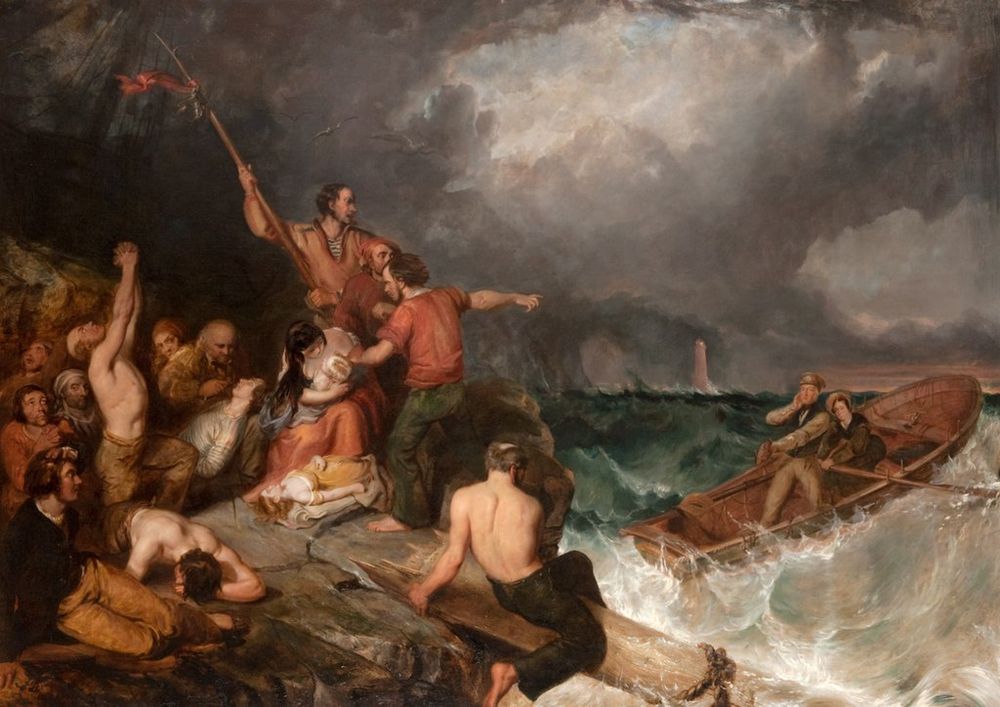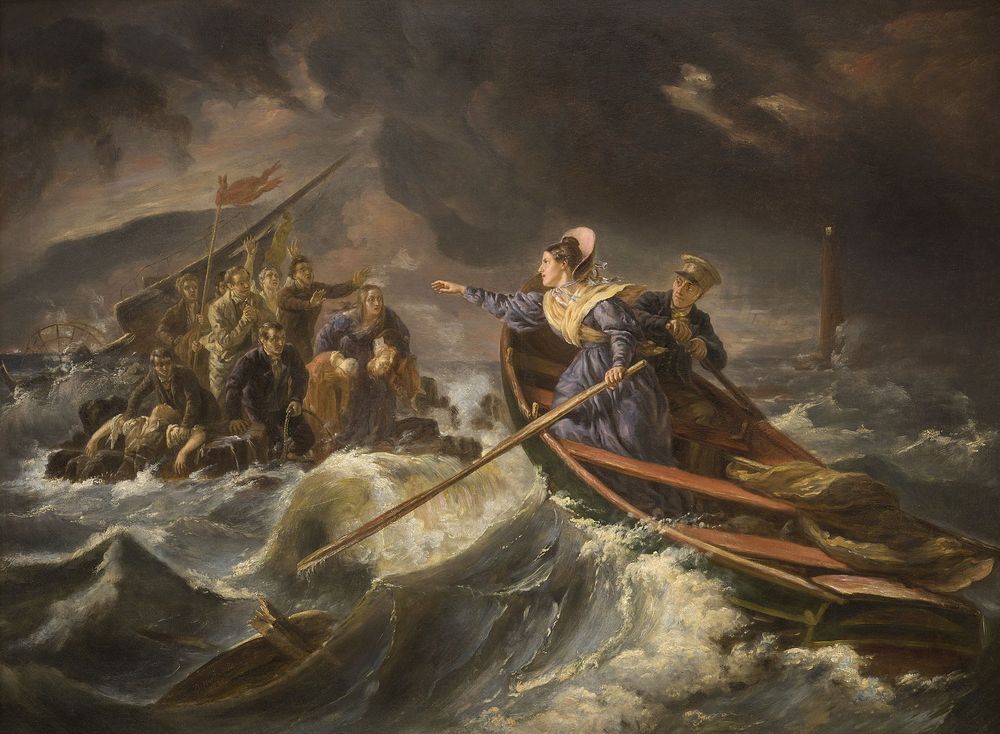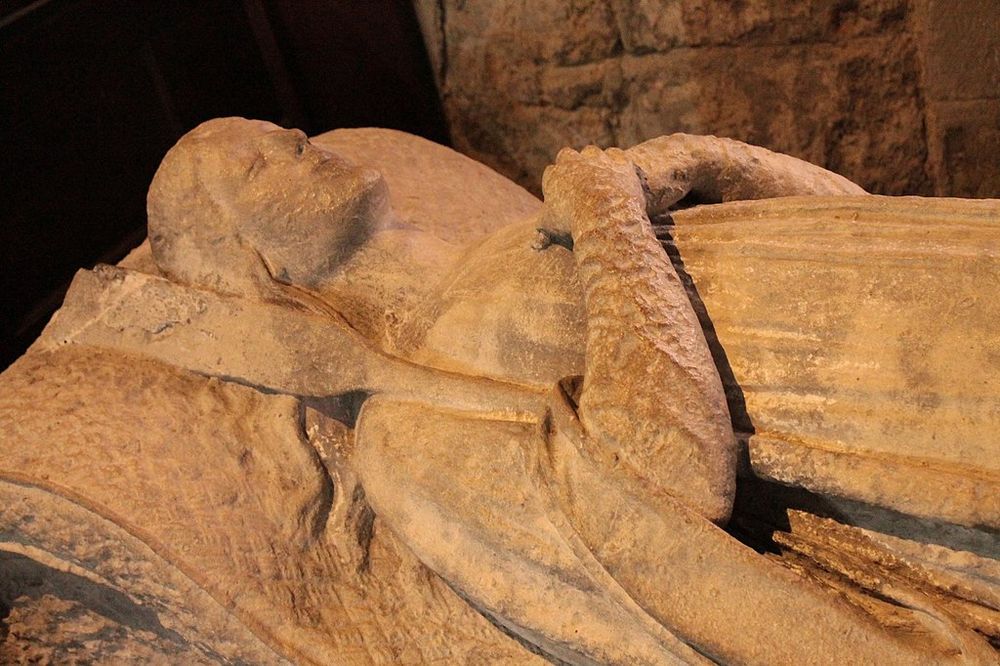In 1838, a young woman pulled off a heroic rescue saving several survivors from a wrecked merchant ship off the coast of Northumberland in northeast England. Her name was Grace Darling, and she was the daughter of a lighthouse keeper. Grace’s display of courage and strength struck a cord with the Victorian society, thrusting her into the media limelight where she was feted as a heroine. Even today, Grace Darling’s name invokes admiration among people who know her story.

“Grace Darling at the Forfarshire” by Thomas Musgrave Joy.
Grace Darling was born on 24 November 1815 in Northumberland. She was the seventh of nine children born to William and Thomasin Darling, and when only a few weeks old, she was taken to live on Brownsman Island, one of the Farne Islands, in a small cottage attached to the lighthouse, where her father was the keeper. While the accommodation at Brownsman was comfortable, the lighthouse was not located in a good place to guide shipping to safety. So in 1826, the family moved to the newly constructed lighthouse on Longstone Island.
Longstone Lighthouse had better accommodation, but the island itself was slightly less hospitable. Every week William would row back to Brownsman to gather vegetables from their former garden and to feed the animals. The family spent most of their time on the ground floor of the lighthouse, which consisted of a large room, heated by a wooden stove. The room was their living room, dining room, and kitchen in one, and had a spiral staircase leading to three bedrooms above and the light at the top of the tower.

“Grace Darling” by Thomas Musgrave Joy.
In the early hours of 7 September 1838, Grace Darling was looking from an upstairs window when she spotted the wreck of the Forfarshire that had crashed against Big Harcar, a low rocky island, during a storm the previous night. The Forfarshire had set out from Hull on September 5, sailing north heading for Dundee, with 61 passengers and crew and a cargo of cotton. The Forfarshire had recently undergone a series of repairs on her boiler that was not completed resolved. No sooner had Forfarshire started her journey, the ship’s boiler began to trouble her once again. Instead of stopping for repairs at the nearest port, Captain Humble pushed on and even pressed the passengers into pumping water that was leaking uncontrollably from the boiler into the hold.
That night, the boilers finally gave way and the engine stopped. With a storm brewing over the horizon, the captain hosted two sails that were reserved for emergencies. As the weather deteriorated and without power, the captain turned the Forfarshire back to the south, to try to find safety behind the Farne Islands off Northumberland. As the Forfarshire approached the Farne Islands early in the morning, Captain Humble may have mistaken the two lighthouses—one on Brownsman and the other on Longstone, manned by Grace and William Darling—and thought the ship was safely between the mainland and the innermost island. Instead they were drifting closer and closer to Longstone Lighthouse which was surrounded by dangerous rocks.

LongStone Lighthouse. Photo: ianpreston/Flickr
In the early hours of the morning, the ship crashed into the rocks at Big Harcar, about a mile from the lighthouse. A group of eight sailors and a passenger managed to lower and escape in a lifeboat, to be picked up the following morning by a passing schooner bound for Hull. The remaining passengers and crew were left to the mercy of the sea, which swung the Forfarshire around and tore off the stern quarterdeck and cabins, leaving only the bow and fore sections of the ship anchored to the rock.
Grace spotted the distressed ship at five in the morning but there was not enough light to discern whether there were any survivors. It wasn’t until two hours later that Grace, using her telescope, counted about a dozen people clinging onto the rocks. Grace pleaded her father to go to the rescue, but he initially refused because the sea was too rough and the two of them could not possibly manage their only boat in such conditions, his sons being away.
Related: Ida Lewis: The Bravest Woman in America
After a short breakfast, though, Grace prevailed and they set off in a 21-feet clinker-built open rowing boat designed for a minimum crew of three strong men. Rowing against the terrifying waves, the Darlings arrived at Big Harcar, to find that only nine survivors remained. William left Grace to hold the boat steady whilst he assisted the transfer of four of Forfarshire's crew, including the only surviving woman, a Sarah Dawson, to the boat. William, with the aid of two of the rescued crew, then rowed the boat back to the lighthouse while Grace comforted Mrs. Dawson, who had by this time lost the bodies of her two children to the sea.

Painting of Grace Darling rescuing survivors of Forfarshire by Charles Achille d'Hardiviller.
Grace remained behind at the lighthouse to attend to the survivors while her father and three of the rescued crew members rowed back and recovered four more survivors. The survivors confirmed that 13 had made it to the rock during the night, but four had been swept away shortly before the arrival of Grace and William. Forty-three passengers and crew, including the captain and his wife, perished.
News of the rescue spread quickly, and Grace won great admiration from far and wide. Queen Victoria herself wrote to Grace praising her conduct and awarded her £50 for her courageous actions. More than a dozen portrait painters sailed to her island home to capture her likeness, and hundreds of gifts, letters, and even marriage proposals were delivered to her. Grace also received countless letters requesting locks of her hair and scraps of the dress she wore during the rescue. In compiling with these requests, the humble Grace lost so much hair that those close to her began to fear she would soon need a wig. Her image and name were even used to sell chocolates and soap. Depictions of Grace mid-rescue began to adorn trinkets, tea-caddies, plates, postcards, and girls’ annuals. These mass-produced mementoes enabled her story to pervade households across the country.

A chocolate bar featuring an image of Grace Darling. Photo: Benjobanjo23/Wikimedia

Effigy of Grace Darling at St Aidan's Church, Bamburgh. Photo: Stephencdickson/Wikimedia
In addition to newspaper articles, paintings and trinkets depicting Grace Darling, a number of books and poems were written about the rescue and the family, the most notable being Grace Darling, or the Maid of the Isles by Jerrold Vernon (1839), and Grace Darling by William Wordsworth.
Grace Darling died four years later from tuberculosis. She was buried in the churchyard of St Aidan's Church, Bamburgh. At the west edge of the churchyard, north of her grave, a monument with her sleeping effigy holding an oar was erected.
In the centenary of her heroic rescue, in 1938, a Museum dedicated to Grace and seafaring in the region was founded at her birthplace, Bamburgh.












Amazing story! Grace would have made a wonderful nurse. Sad she died so young.
ReplyDelete